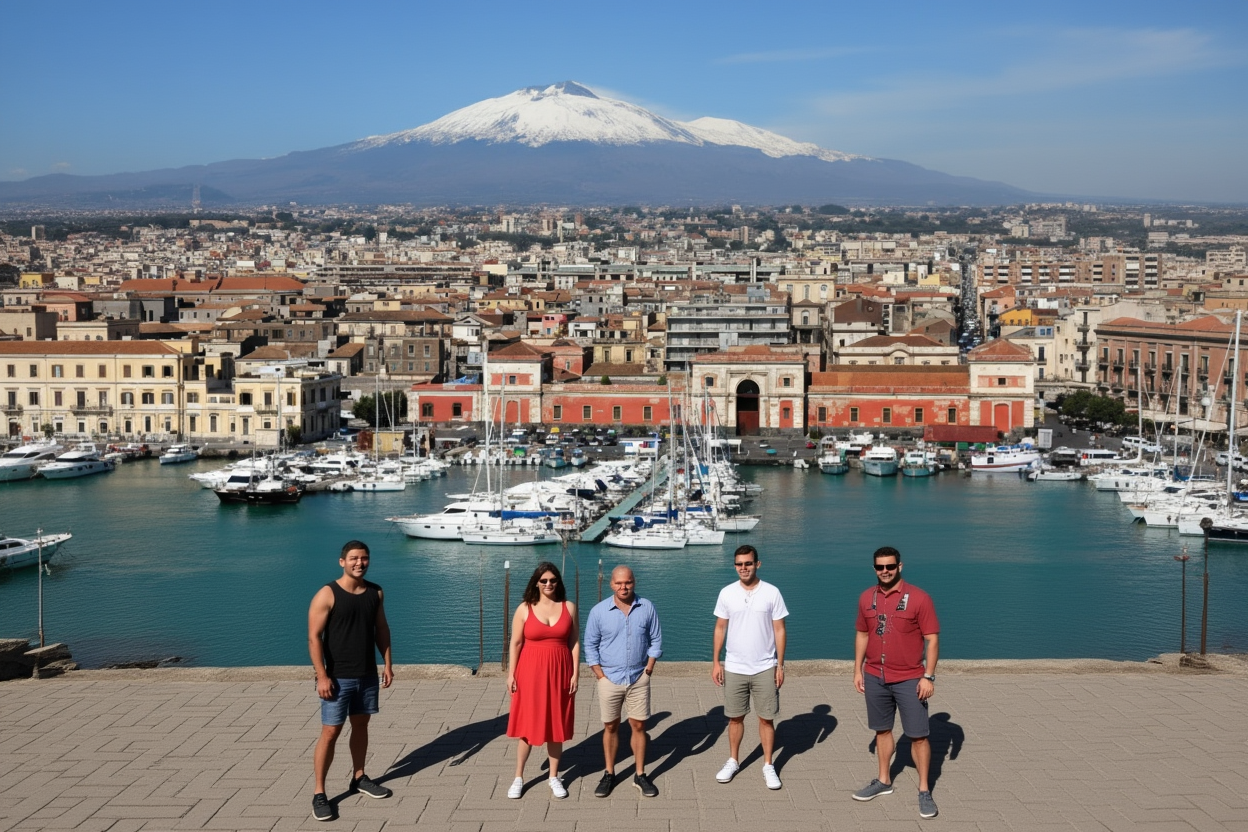Mongibello Etna is one of the most iconic and fascinating volcanoes in the world. Located on the eastern coast of Sicily, Italy, it rises majestically above the surrounding landscape, its slopes covered in fertile soil, vineyards, and small villages. Known for its frequent eruptions and striking presence, Mongibello Etna is not just a natural wonder but also a key part of Sicilian culture and history.
Geographically, it is Europe’s tallest and most active volcano, making it a natural laboratory for scientists studying volcanic activity. Culturally, it has inspired myths, art, and traditions for centuries, influencing local communities who live in its shadow. For travelers, it offers breathtaking scenery, adventure, and a glimpse into the raw power of nature.
In this article, you will discover the geological story of Mongibello Etna, the life that thrives on its slopes, ways to experience its trails and tours, the science behind its eruptions, and its cultural significance. You will also learn practical tips for visiting safely and understanding the environmental impact of tourism.
The Origins and Geological Story of Mongibello Etna
Mongibello Etna has a long and fascinating geological history. Scientists believe that the volcano began forming hundreds of thousands of years ago, making it one of the oldest active volcanoes in the world. Its name, “Mongibello,” comes from the Italian words monte meaning mountain and bello meaning beautiful, which reflects both its grandeur and its scenic beauty.
The volcano is built from layers of lava, ash, and volcanic rocks, which have accumulated over countless eruptions. These layers tell a story of both explosive and gentle lava flows that have shaped the landscape over millennia. Its slopes are dotted with craters, some active and others dormant, each marking a chapter in its long life.
Mongibello Etna’s eruptions are a key feature of its character. Unlike some volcanoes that explode violently and disappear, Etna often produces flowing lava that creates new land and enriches the soil. Scientists monitor its activity closely, studying patterns of magma movement, gas emissions, and seismic activity to understand both its past and future behavior.
Life on the Slopes: Flora, Fauna, and Local Communities
The slopes of Mongibello Etna are home to a surprisingly rich ecosystem. Despite the volcano’s fiery activity, many plants and animals thrive here. Pine forests, oak trees, and Mediterranean shrubs cover the lower slopes, while unique alpine plants can be found near the summit. These plants adapt to the volcanic soil, which is rich in minerals and nutrients.
Volcanic soil has a special effect on agriculture in the region. Farmers grow grapes, citrus fruits, olives, and vegetables that are renowned for their flavor. The fertile land has supported human settlement for centuries, and local vineyards produce wines that reflect the unique characteristics of Etna’s terrain.
Communities living near Mongibello Etna have adapted to life with an active volcano. Towns such as Nicolosi, Zafferana Etnea, and Randazzo showcase traditional Sicilian architecture and culture. Residents celebrate local festivals, harvests, and religious events that often honor the volcano itself. Life here is closely tied to the rhythms of nature, combining resilience with a deep respect for the natural world.
Experiencing Mongibello Etna: Tours, Trails, and Sights
Visiting Mongibello Etna is a memorable experience for any traveler. The volcano offers a variety of trekking routes, from gentle walks in the lower forests to challenging climbs near the summit. Many guided tours provide safe access to active craters, allowing visitors to witness volcanic activity at close range.
Scenic viewpoints along the slopes offer breathtaking panoramas of Sicily and the Mediterranean Sea. The Silvestri Craters are particularly popular for their accessibility and dramatic volcanic landscape. During winter, snow-capped peaks provide a stunning contrast to the lush lower slopes, while in summer, hiking trails wind through volcanic rock formations and wildflowers.
Seasonal considerations are important when planning a visit. Winter months can be cold and icy near the summit, while summer offers clearer skies but warmer temperatures. Local guides can provide not only safety advice but also insight into the natural and cultural history of the region, enhancing the experience for visitors.
The Science Behind Etna’s Eruptions
Mongibello Etna’s eruptions are a captivating combination of natural power and scientific interest. Volcanic activity occurs when magma from deep within the Earth rises toward the surface. This process can produce flowing lava, ash clouds, and sometimes explosive events, depending on the pressure and gas content of the magma.
Throughout history, Etna has erupted many times, with some events causing significant damage to nearby towns and agriculture. Despite this, its eruptions have also created fertile soil, shaped the landscape, and provided important data for volcanologists. Studying these eruptions helps scientists predict future activity and understand volcanic processes worldwide.
Modern monitoring techniques include seismic sensors, satellite imagery, and gas analysis. These tools allow researchers to track changes in the volcano’s behavior in real time, helping to ensure public safety and provide early warnings for potential eruptions.
Cultural and Historical Significance of Mongibello Etna
Mongibello Etna is deeply embedded in Sicilian culture and history. Myths and legends often describe the volcano as the home of gods or giants, symbolizing both destruction and creation. Ancient Greeks and Romans referred to Etna in their writings, and it continues to inspire artists, writers, and filmmakers today.
The volcano also influences local cuisine and traditions. Vineyards on its slopes produce distinctive wines, while the mineral-rich soil contributes to the flavor of fruits and vegetables. Cultural festivals celebrate the land, the harvest, and the enduring presence of Etna, creating a strong connection between people and nature.
Etna’s significance extends beyond Sicily. It is a UNESCO World Heritage site, recognized for its natural beauty, scientific importance, and cultural impact. This recognition highlights the volcano as both a symbol of Sicily and a site of global interest.
Safety and Environmental Considerations
Exploring Mongibello Etna requires attention to safety and environmental impact. Visitors should follow marked trails, respect warning signs, and consider using guided tours, especially near active craters. Proper clothing, footwear, and knowledge of weather conditions are essential for a safe experience.
Conservation is also important. Tourism can impact fragile ecosystems, and visitors are encouraged to minimize waste, stay on designated paths, and respect wildlife. Local authorities and organizations work to preserve both the natural environment and the cultural heritage of the region, ensuring that Etna remains a place of wonder for future generations.
Conclusion
Mongibello Etna is more than just a volcano; it is a living symbol of nature’s power, beauty, and resilience. Its geological story, thriving ecosystems, and rich cultural history make it a fascinating destination for scientists, travelers, and locals alike.
Whether you are drawn to its scientific significance, the adventure of hiking its slopes, or the cultural stories woven into its landscape, Mongibello Etna offers a unique experience that connects people to the natural world. Visiting responsibly and with curiosity allows us to appreciate both the majesty and the subtle lessons this extraordinary volcano provides.
Mongibello Etna remains a testament to the enduring interplay between nature and human life, inviting everyone to explore, learn, and marvel at one of Europe’s most remarkable natural wonders.
My name is Micheal Lovell. I am a dedicated travel writer with over 7 years of experience in creating informative and engaging travel content. Throughout my journey, I have published travel blogs that help readers explore new destinations, plan better trips, and discover local cultures and hidden gems around the world. My goal is to provide practical travel insights through well-researched articles that inspire and guide travelers at every step of their journey.










